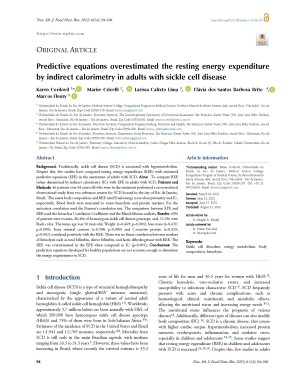Predictive equations overestimated the rest energy expenditure by indirect calorimetry in adults with sickle cell disease
Abstract
Background: Traditionally, hypermetabolism is described in sickle cell disease (SCD). Despite this, few studies have compared rest energy expenditure (REE) with estimated by predictive equations (EEE) in the assessment of adults with SCD. Aims: To compare REE values determined by indirect calorimetry (IC) with that EEE in adults with SCD. Subjects and Methods: A cross-sectional observational study was performed with 46 individuals over 34 years old in the treatment from two reference centers for SCD located in the city of Rio de Janeiro, Brazil. The dual-energy X-ray absorptiometry (DXA) and IC were used to assess BC and REE, respectively. Blood levels were measured to assess hemolytic and protein markers. Pearson’s correlation test was used in the univariate correlation. The Intraclass Correlation Coefficient (ICC) and the Bland-Altman analysis were used in the comparison between EEE and IC. P-values ≤ 0.05 were considered statistically significant. Results: Most participants were from the female sex, Hb SS genotype (80.4%) and with black color (52.2%). The mean age was 50 years old. Weight (r= 0.469; p=0,001), LM (r = 0.631; p=0.000), BMC (r = 0.508; p=0.000) and CRP(r=0.319; p = 0.002) correlated positively with the REE. There was no linear correlation between makers of hemolysis with REE. The REE was overestimated in the EEE when compared to IC (p<0.001). Conclusions: The prediction equations developed for healthy populations are not accurate enough to determine the energy requirements and more studies are needed to better understand how REE role in middle-aged and elderly adults with SCD.
Full text article
Authors
Copyright (c) 2022 Karen Cordovil, Marise Crivelli, Larissa Calixto Lima, Flavia S. Barbosa, Marcos Fleury

This work is licensed under a Creative Commons Attribution 4.0 International License.
-
Attribution — You must give appropriate credit, provide a link to the license, and indicate if changes were made. You may do so in any reasonable manner, but not in any way that suggests the licensor endorses you or your use.
-
No additional restrictions — You may not apply legal terms or technological measures that legally restrict others from doing anything the license permits.





